
Just like the nutrition labels on the foods we eat, the nutrition label on your pet's food is designed to help you learn more about the product by providing information about the ingredients, nutrient levels, and nutritional adequacy.
But navigating the pet food aisle can be a tricky business. Pet food labeling is not exactly the same as human food labeling. Though there are specific pet food labeling requirements which are strictly regulated by the FDA, words on the label can be misinterpreted and marketing claims can be subjective.
As a pet owner who is focused on their pet's health and well-being, it's a good idea to learn how to decode these pet food labels. The more skilled you are at interpreting nutrition labels, the better you'll be able to find the best food for your pet's individual needs.
We recently conducted a survey to determine where pet owners get stumped the most when decoding pet food labels. Our survey yielded interesting results, which may help you make better decisions when choosing your pet's food based on the nutrition label.
Knowing the meaning and importance of the items on your pet food labels only matters if pet owners are actually reading the labels. The good news is that our survey data showed that by a wide margin pet owners do read the ingredients and nutrition data on pet food labels. An overwhelming 92% of respondents said they read the ingredients list when buying new pet food, with more than half of those doing so "always" or "often".
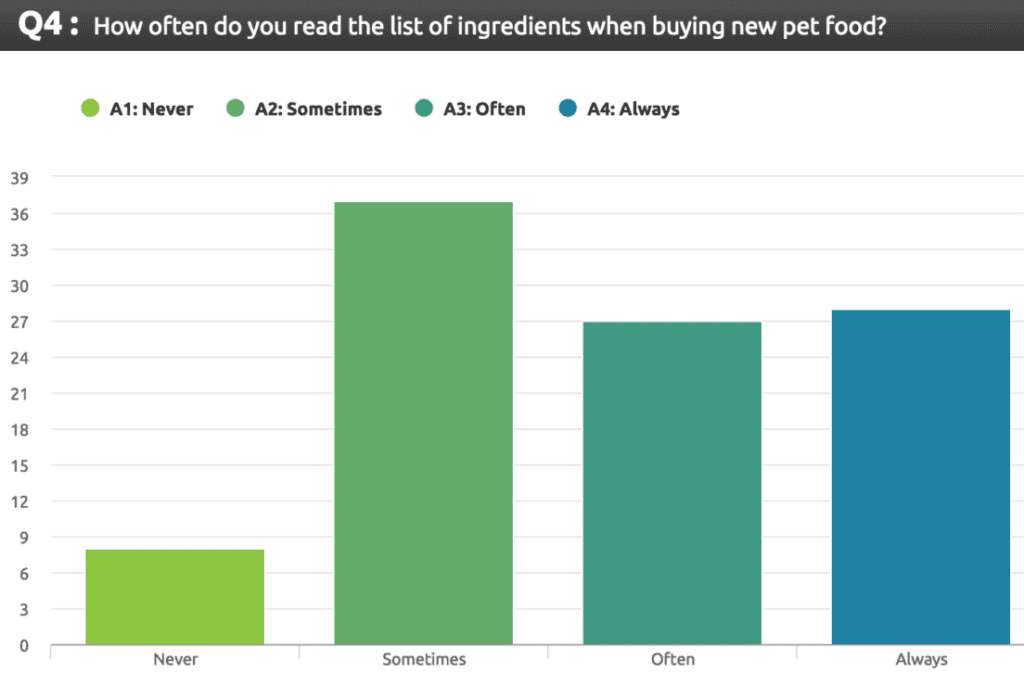
Of the 8% who never read the ingredients, this may not be due to apathy over their pet's health. It may simply be a result of a lack of information on the packaging. 84% of pet owners said they would be more likely to read the labels if more information regarding nutrition and ingredients were provided.
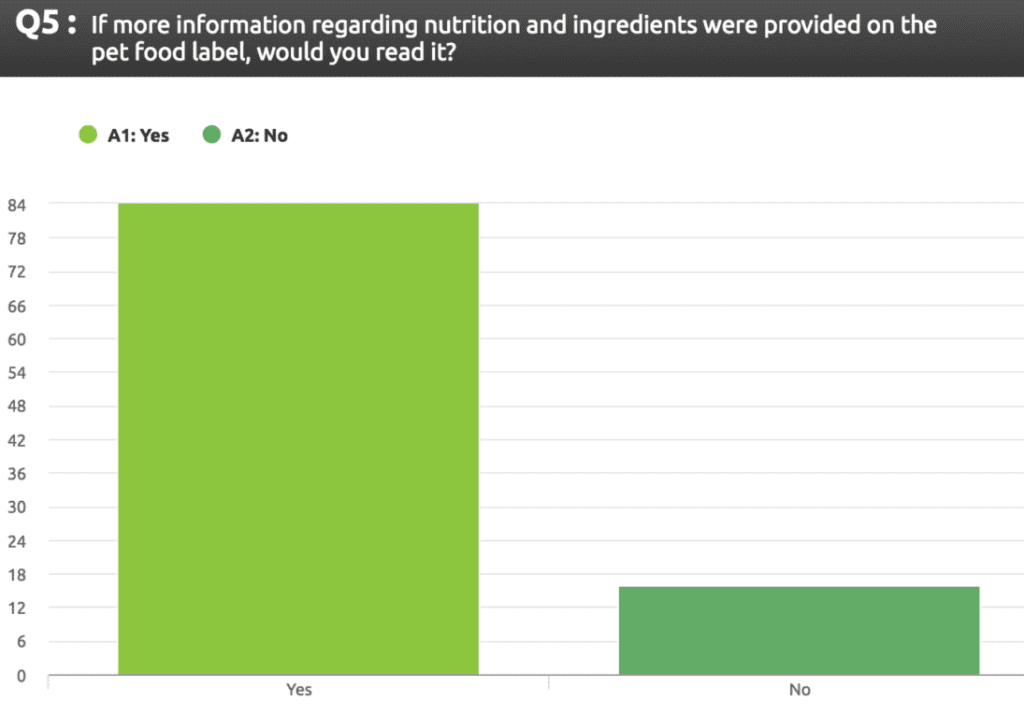
So with all those pet owners reading nutrition labels, what should you be looking for?
No two pets are the same. Therefore, it is not about finding the "right" pet food or the one that's "better" than other foods. You need to look at the food's nutrition label to determine if the food meets your pet's individual needs, including their:

This is done by taking a careful look at the ingredients in your pet's food.
You may notice the ingredient list first when reading your pet food labels, which lists ingredients by weight.
Some pet owners may believe a pet food is healthiest when it lists meat as the first ingredient. However, according to the FDA, meat is 75% water and so without the water weight meat would fall lower on the ingredient list. Meat meals, on the other hand (chicken meal, bone meal, etc) are a different story, as they concentrate animal protein and remove most of the water and fat.
Meat meal can also contain other animal parts as byproducts, such as stomachs, blood, bone, brains, cleaned intestines, hearts, tongues, livers, and udders. This does not include horns, teeth, or hair.
While meat byproducts aren't bad for your pet's health (and in fact your pet probably loves them), preservatives and stabilizers in pet food are controversial for some owners. These ingredients must be approved by the Food and Drug Administration. The FDA says that preservatives are largely safe, but some pet owners and scientists disagree.
If you're unsure about feeding your dog artificial ingredients and the shelf-life of your pet food isn't a major issue, it's a good idea to check the nutrition label on your pet food's packaging. Artificial ingredients and preservatives typically include high fructose corn syrup and benzoyl peroxide.
So if artificial ingredients are not ideal, how does a pet owner determine which products have ingredients that are natural? Or is it organic? Holistic maybe? Or...?
The ingredients included in pet food labels are crucial to many pet owners as evidenced by the results of our Pet Food Packaging Survey. But when it comes to terms like Organic, Holistic, Natural and Human Grade, are these nutritionally meaningful terms or just buzzword marketing? And do they impact pet food owners' buying decisions?
First, it helps to understand the key differences between these words that are important to know when reading your nutritional label:
Now that we understand better what these terms mean, how do they actually impact pet owners' purchasing decisions? Our survey results tell an interesting story.
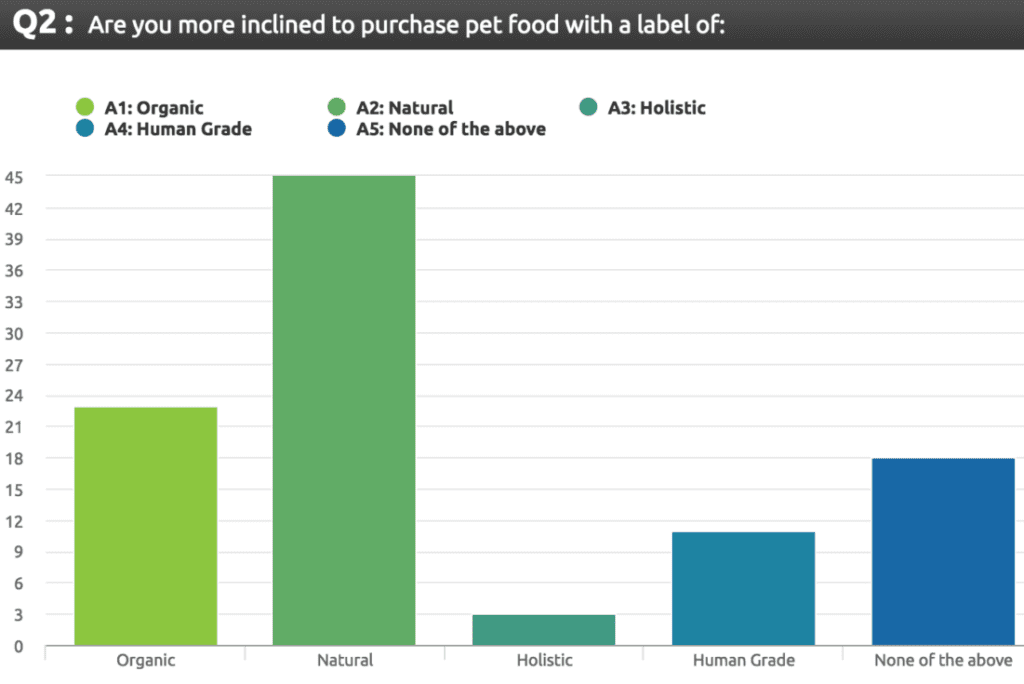
What about the more nutritionally vague marketing terms like "gourmet" and "premium" -- do those impact buying decisions?
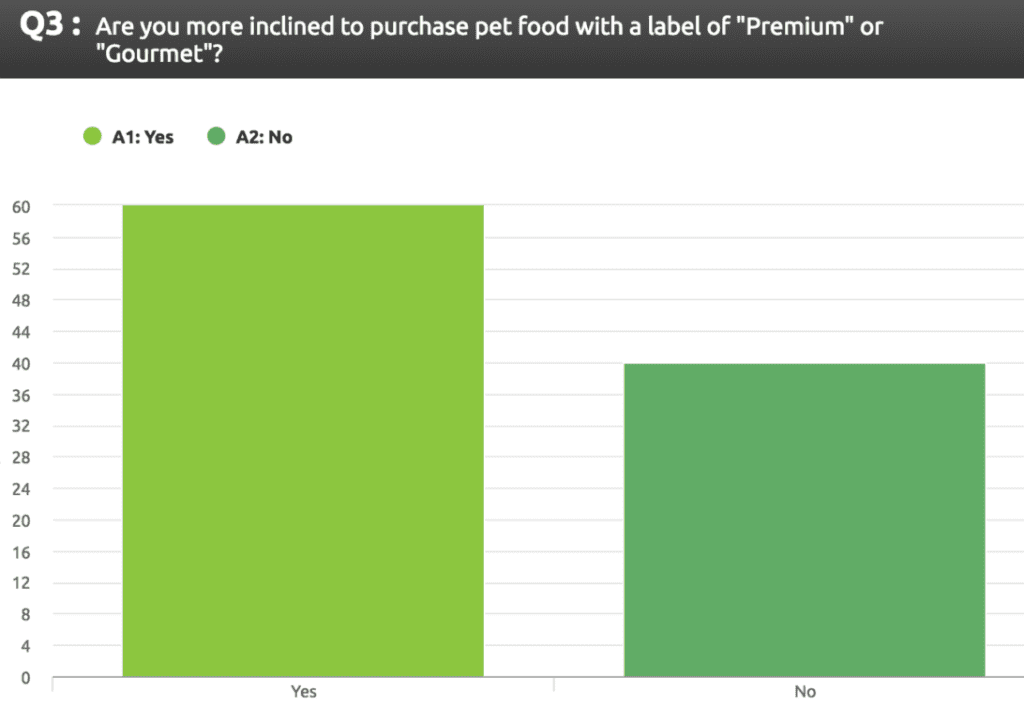
Our survey data shows that a majority of pet owners do respond positively to these terms, but at 60% it is not an overwhelming majority. This indicates that pet food shoppers may see these terms as a bit too vague or empty to have any real meaning to them, or perhaps they feel the product may be more expensive than they can (or want to) pay.

The AAFCO (Association of American Feed Control) is a voluntary membership association that establishes the nutritional standards for complete and balanced pet foods. Though they have no legal authority to regulate pet products, most states follow AAFCO model regulations. Enforcement of violations is the purview of local, state, and federal agencies that are charged by law to regulate the distribution and sale of animal drug remedies and food.
An AAFCO statement on pet food determines the nutritional adequacy of the product. It ensures that the food is balanced and complete for your pet's specific life stage and physical activity. It also determines if the food doesn't meet the complete and balanced requirements that the pet food claims.
A pet food product can make the claim that it's nutritionally balanced and complete if it meets one of these three requirements:
The AAFCO statement on a pet food's nutritional label is a crucial component in determining that the food's claims for nutritional value are true. But that doesn't mean an AAFCO statement is enough for pet owners to consider buying a new type of pet food. Our survey results found that the majority of pet owners (67%) said they do not look for an AAFCO statement on their pet's food when they buy it.
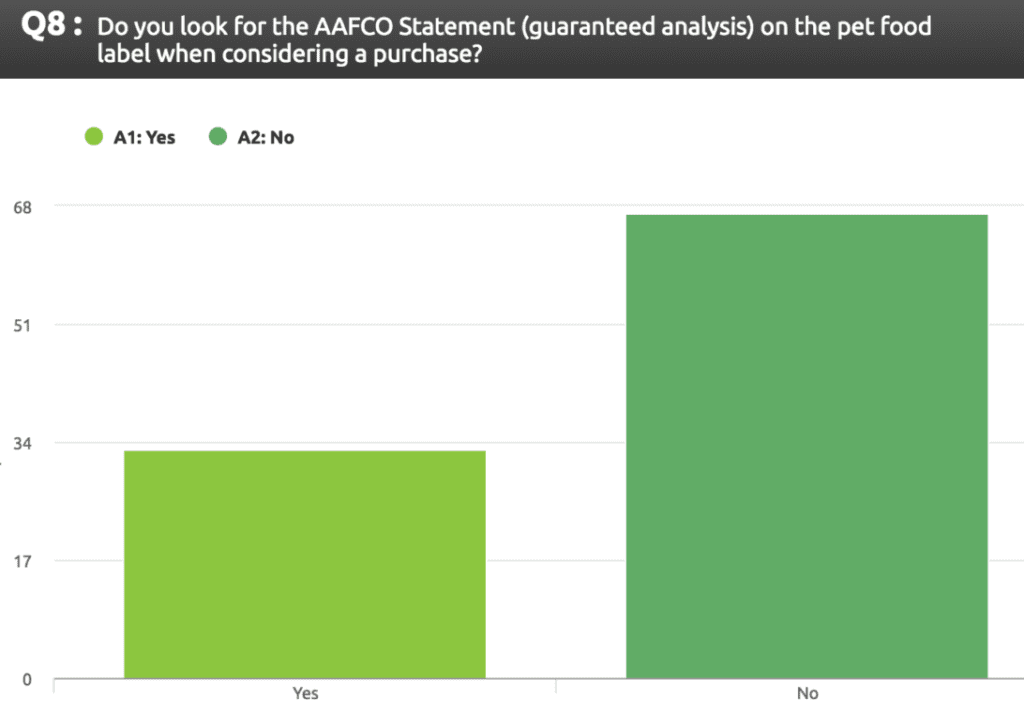
Considering AAFCO protocols test pet foods based on the pet food's claims, which include feeding times, it's a good idea to follow these instructions. After all, the nutritional values and benefits indicated on the product are in large part based on the presumption that the pet will be fed according to the recommended directions.
However, our survey indicated that more than 40% of pet owners do not follow the feeding directions on their pet food labels.
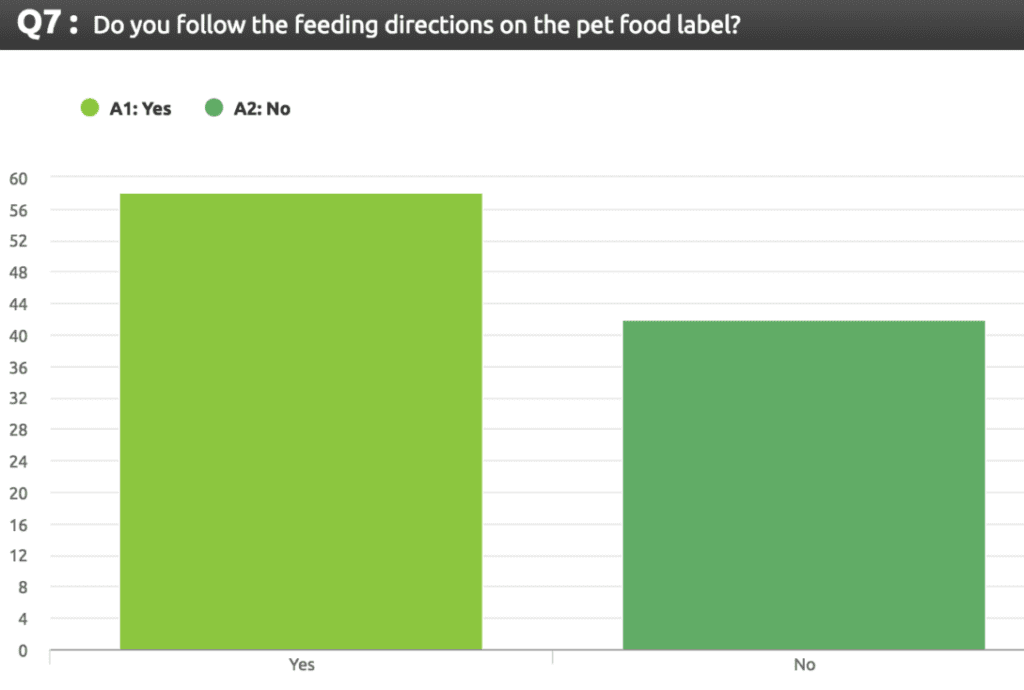
This may be another opportunity for pet food brands to take a look at their packaging and labeling to ensure they are utilizing their packaging real estate most effectively to ensure this crucial information is not being buried or overlooked. Though this may seem like a relatively insignificant finding, factors like these that directly correlate to a pet's health and well-being are likely to correlate to the owner's own satisfactions with the product, translating into higher sales and brand loyalty.
When pet food brands provide nutritional information in detail on their products, it's a win-win situation both for the pet owner and the pet food company. Our survey found that it is the packaging and nutritional information on a product that is the most significant influence on a pet food owner's purchasing decision -- more important than advertising, referrals and other research.
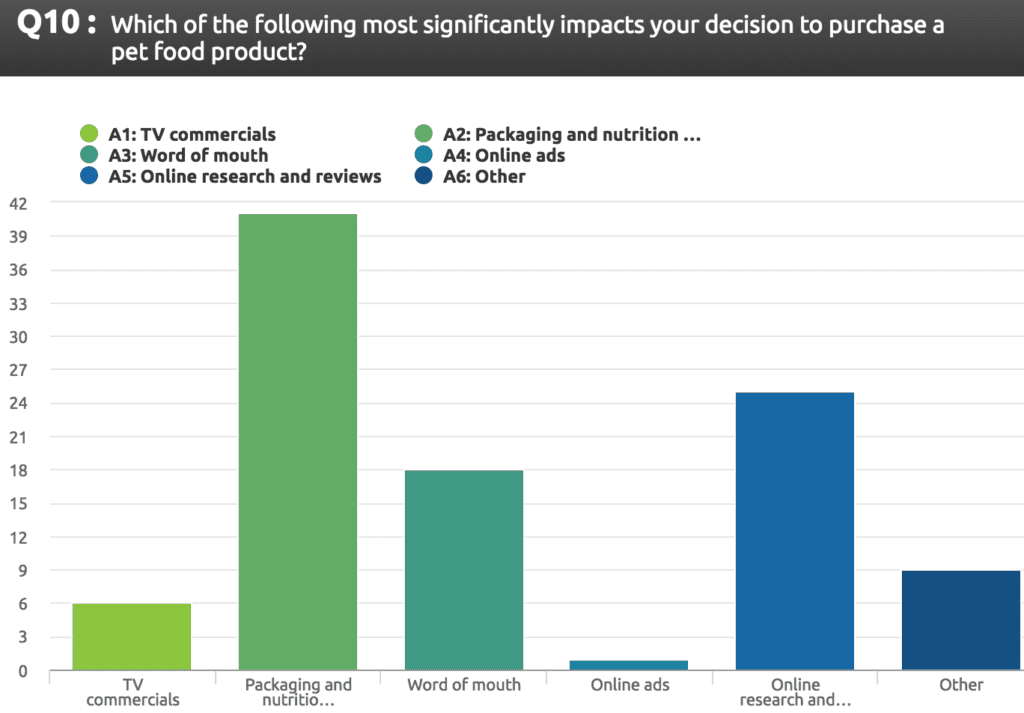
Which of the following most significantly impacts your decision to purchase a pet food product?
With so many pet food owners making their purchasing decisions based on the packaging and labeling, it begs the question as to what specific aspects of a pet food product's labeling would make a pet owner less likely to buy that product over another one. Our survey showed that a lack of information and difficult to read text were the most significant factors.
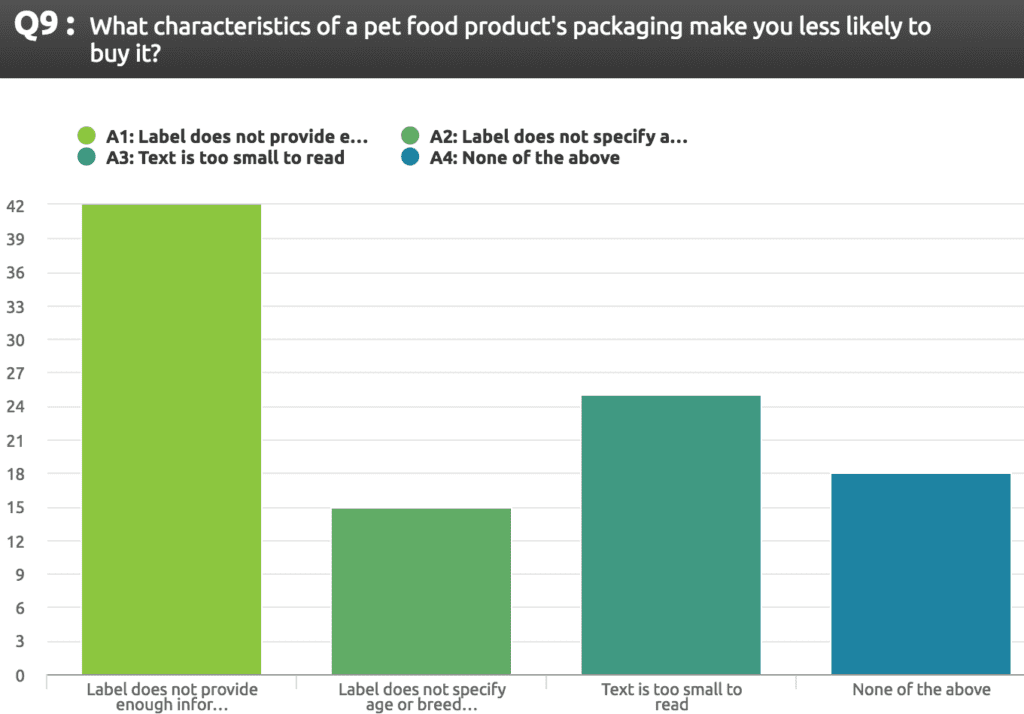
What characteristics of a pet food product's packaging make you less likely to buy it?
The numbers don't lie. 84% of pet owners want more information on pet food labels. 42% say the biggest factor in choosing a pet food is its label information. 41% says the biggest deterrent against purchasing a pet food is the lack of information on the label.
What does this all mean for pet food brands?
The data overwhelmingly indicates that consumers want more detailed and clear information on their pet food products. Pet food brands must be sure they are supplying enough information about their product to their consumers, in a clean, clear and easy-to-find way.
Today's labeling constructions and technological advances mean that there are numerous ways to achieve these goals, ensuring that both marketing information and required regulatory information can live together on packaging labels in a harmonious and effective manner. Extended content labels, such as booklet, fold-out and peel-reseal labels can provide a clean way to incorporate a lot of information in a small amount of physical package space.
By supplying consumers with more information about the nutritional value and the ingredients that go into their products, pet food brands can not only make their consumers happier but they can also boost their own sales. When pet owners have the information they need, they'll be more likely to buy the product and pass on a good word about the product both online and by word of mouth. But before they can do that, they need to know that the product they're buying really is the best option for their pet's needs.
© 2024 Premium Label & Packaging Solutions | PLPS Sales Terms and Conditions